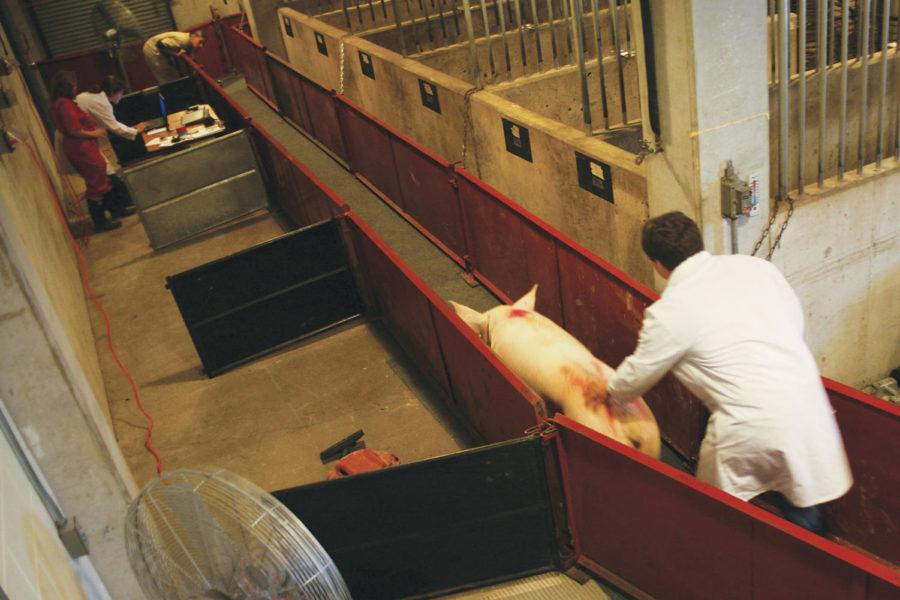ISU Researchers work to fix lameness issues in sows
Courtesy photo: Dr. Locke Karrik
Clay McGargill, fourth year veterinary medicine, directs a sow down the walkway in the Swine Intensive Studies Lab. The walkway has sensors on the floor that record how the sow walks to determine if it has a lameness issue due to such factors as sore feet or legs.
October 24, 2010
They’re pink, black, brown or a combination of colors. Some roll around in the mud all day while others take care of their young. People may think they smell odd, but they like to classify their scent as a special “perfume” or “cologne.”
October is National Pork Month. With Iowa being a predominately agricultural state, one does not have to look far to find this animal species. One does not even have to leave Ames.
Several ISU professors have been conducting research on lameness issues in sows — adult female swine.
The project involves determining what kind of treatments can be administered to sows exhibiting lameness due to disease, sore legs or some other form of pain.
“We want to find cheap resources for farmers to use and prevent the farmer from getting rid of the sow,” said Anna Butters-Johnson, assistant professor of animal science.
Butters-Johnson said lameness is one of the top reasons why farmers remove sows from their herd. Sows will typically reproduce three litters of piglets. If a farmer removes a sow from the herd before it has produced three litters, the farmer loses money.
Since the sows cannot verbally communicate they are in pain, the researchers look for other signs that show the animal is uncomfortable. Butters-Johnson said these signs can be shown through a variety of forms, including shifts in how the sow walks, changes in the sow’s drinking and eating frequencies and problems while trying to get up.
The researchers conduct their study on the sows in the Swine Intensive Studies Lab. The lab is equipped with a variety of technologies that help detect signs of lameness in the sows, including a scale with sensors that measure the amount of weight the sow puts on each foot and a walkway with sensors and cameras to record how the sow walks.
Butters-Johnson said the sows must first be trained so they are accustomed to the equipment before any research is conducted.
“It takes three to four days of attention, care and bribing with cookies,” Butters-Johnson said of the training process.
Since the sows tested in the lab do not have any lameness issues, the professors irritate a foot of the sow to help validate the testing equipment.
“We bring in healthy animals and induce lameness that resolves itself within a week,” said Ken Stalder, professor of animal science.
From the results of their study, the researchers can determine what method of treatment is best for the various causes of lameness.
Stalder said the results of the study will benefit sows, farm workers and farmers alike. The sows will benefit because their pain will be relieved sooner. Workers will not have to deal with lame sows, which can be labor intensive. Farmers will be able to make an educated decision of whether it is best to treat the lameness issue or sell the sow.
“On three levels it’s a bang for your buck,” Stalder said.
This is the first time a study like this has ever been conducted on swine, so it is a learning process for everyone.
“We’re entering uncharted waters, which is sometimes exciting and overwhelming,” Butters-Johnson said.
The researchers hope to create posters that can be hung in swine buildings with a list of the signs of lameness farmers and producers should look for in sows.

















